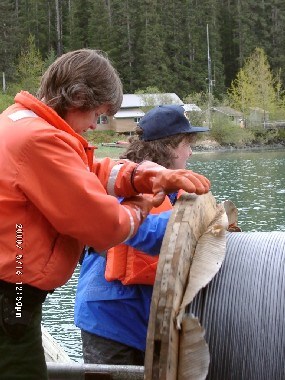What was the impetus for this project?
In 1996, GBNP completed its Vessel Management Plan, designed to accommodate increased visitation to the park while protecting sensitive park resources. The Plan regulates the number of vessels allowed to enter the bay, and implements vessel course and speed restrictions in areas where whales are present (referred to as 'whale waters'). Although GBNP has a variety of resource concerns related to vessel traffic, park staff are particularly concerned about the potential disturbance of endangered humpback whales by vessel noise.
Why monitor underwater sounds?
Endangered humpback whales feed during summers in Glacier Bay. Research shows that whales may move away from preferred feeding areas when disturbed by vessel sounds. Repeated disturbances could be detrimental to Alaskan humpbacks, who must feed enough during the summer to sustain themselves through their 3,000 mile roundtrip migration to and from Hawaii. Vessel noise can also interfere with whale communications, increase the opportunity for collision between vessels and whales, or cause short or long-term hearing loss. Park staff are interested in learning what, if anything, can be done to minimize sound disturbance of marine mammals in the park. The data gathered during this study will help park managers fine-tune vessel management regulations.
The specific objectives of the research are to:
- Describe 'natural underwater sounds" such as wind, rain, and animal vocalizations
- Describe vessel-generated sounds (frequency, loudness, duration, and how far the sound travels) in lower Glacier Bay
- Determine the frequencies and loudness of vessel-generated sound that whales and other marine life are exposed to
- Determine how vessel numbers, speed and other operating parameters affect underwater sound
How loud is too loud? Does the Park have an upper threshold of acceptable noise?
Not yet. Once we have collected data on the proportion of underwater noise that comes from vessels, the sound levels marine mammals are exposed to, and how much variability in sound levels there is on a daily basis, the Park will work with Navy acousticians to develop "noise goals". "Noise goals" will then guide the Park's vessel management practices.
Is the park interested in all vessel noise, or just cruise ship noise?
We are able to "hear" all vessel types using the hydrophone. While larger vessels like cruise ships are certainly loud at greater distances than smaller vessels, other types of vessels can produce equivalent underwater noise levels at close range. In 1999, 5 cruise ships volunteered to individually visit the Navy's underwater listening station in Ketchikan to obtain a vessel "sound signature". The resulting data allowed GBNP to evaluate the effects of engine type and operational conditions (including speed, engine RPM and propeller pitch) on their underwater sound output. In fall 2000 and 2002, we obtained similar 'sound signatures' of a variety of Park Service vessels in Bartlett Cove by asking them to navigate near the hydrophone at a specified course and speed. The results are available in reports found on this web site. If you are planning to be in Bartlett Cove and are interested in obtaining a sound signature for your vessel, please contact e-mail us
Will acoustic monitoring results lead to more restrictions on vessels in Glacier Bay?
Gathering underwater sound data will allow park managers to evaluate its vessel management policies. For example, ambient noise data have revealed that lower Glacier Bay is quieter on average when there is a 10 knot speed limit in effect, compared to when the speed limit is 20 knots. However, many other factors will also be considered before any changes are made to the existing regulations including: navigational safety, the risk of whale/vessel collisions, visitor experience and effects on other Park resources. In some cases, regulations could become less restrictive.
How will the Park correlate vessel noise data with marine mammal behavior?
After collecting at least one year of ambient noise data, we hope to conduct a behavioral study of whales and other marine mammals to determine what effects vessel sounds have on them. Numerous other studies have shown that vessel noise can cause whales to change their diving and respiratory intervals and be diverted from feeding or resting. Our proposed study would go beyond what is presently known about disturbance by comparing actual underwater sound levels and food availability to whale behavior
Where can I go to hear the sounds being received by the hydrophone?
The audio stream collected by the hydrophone is available on all computers on the Park's computer network. Park visitors can listen to live, real-time underwater sounds at the "listening stations" in the Park Visitors Center and at the Visitor Information Station
Where is the cable laid and how can I avoid snagging it with my boat anchor or fishing line?
The hydrophone and cable are not marked with a buoy or in any other fashion and the cable will likely bury itself in the sand or mud and won't be visible either. However, they are both very vulnerable to damage from anchors, long-lines or clam diggers. Cutting the cable or pulling on it could damage its ability to conduct sound. Moving the hydrophone anchor could bury the hydrophone or damage it.
- The hydrophone and anchor are in approximately 100 ft of water, at the location indicated on the map.
- The cable is laid in very shallow water along the Lester Island shoreline, but should not be exposed except at tides lower than -4 feet below mean lower low water. Even at the highest tides, the cable should be in less than 40 feet of water.



